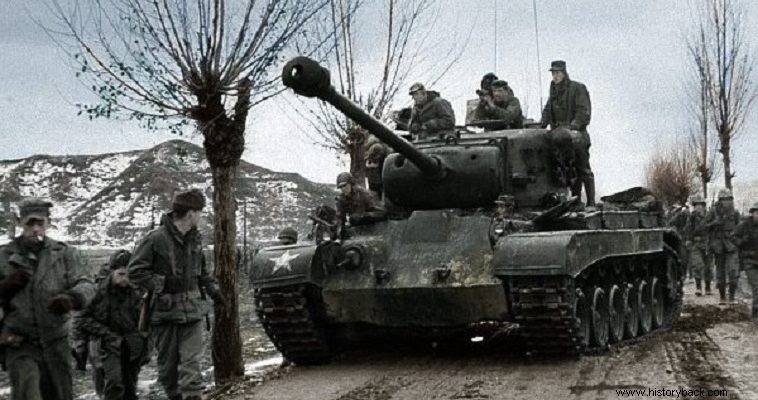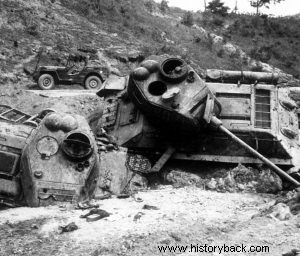
North Korea attacked the South on June 25, 1950 starting the conflict that became known as the Korean War. The North Koreans, reinforced with Soviet T-34/85 tanks, swept through the resistance of the South, who only had a few M8 armored vehicles, and occupied Seoul three days later.
The US mobilized but initially sent M24 Chaffee light tanks to Korea, which had no luck against the T-34/85. The South Koreans and Americans retreated to Pusan with the latter gradually building up their forces. Then the first M26 Pershing tanks were sent to Korea. These tanks saw little action in the last days of World War II and were the "ancestors" of the M46, M47, M48 series. It had strong armor and a 90mm gun
The M26s were the only tanks that could easily deal with the North Korean Soviet T-34/85s. Until the first contact the North Koreans enjoyed absolute tank superiority. Stalin had deployed over 250 T-34/85s to North Korea by June 1950 and deployed at least 80 more by August, along with Su-76 assault guns.
Korean attack
Northern pressure on the Pusan perimeter continued. In one sector of the front, an M26 ulama belonging to the 1st Marine Tank Brigade's A Company under Lt. Granville Sweet, supporting the 5th Marine Regiment, was deployed.
Opposite were units of the North Korean 4th Infantry Division (IP) supported by a brigade of the 109th Tank Regiment equipped with T-34/85s. On August 17th, having information of an impending enemy attack, Sweet ordered his three tanks (one damaged) in line formation along the only road through which the enemy could pass.
So even if the chariots were destroyed they would still block the road. The American lieutenant sent his tanks into a turn where he could hit the enemy before he could respond. Suddenly enemy tanks appeared and began attacking the American infantry. The pedestrians tried to stop them with Bazookas and PAOs (recoilable guns), but failed.
The T-34s continued their movement but heading towards the bend where the M26s were waiting for them. Lieutenant Cecil Fullerton's tank was first against North Korean tanks with a High-Velocity-Armor-Piercing (HVAP) projectile. The American tank fired two more missiles. Fullerton, however, turning to his gunner, Sergeant Stanley Tarnowski, accused him of having missed. But Tarnovski was the best shooter on the island...
What had happened? The American missiles had simply completely penetrated the T-34. The first shell penetrated the armor at the ship's machine gun position and exited the rear of the tank. And the other two tanks had penetrated the T-34's armor...
The next T-34 also received a barrage of missiles. The chariot was hit in the tower and thrown to the side of the road. A third T-34 began firing at the American tanks. But soon he received seven missiles in a row and stopped burning. Three men from its crew tried to abandon it but were mowed down by machine gun fire.
Another T-34 attempted to move away but was intercepted by US infantry and blasted into the air by M26s. It was the first collision of the M26 with the T-34/85. It showed the superiority of the American tanks over the Soviet ones. The armor of the T-34 could not withstand the blows of the 90 mm guns. of American tanks. The superiority of the American tanks was also certified in subsequent conflicts.

T-34 tank on fire.

Damaged tank T-34/85.

A T-26 tank monitors a road in Korea.
